brake fluid HONDA ACCORD COUPE 2001 CF / 6.G Owners Manual
[x] Cancel search | Manufacturer: HONDA, Model Year: 2001, Model line: ACCORD COUPE, Model: HONDA ACCORD COUPE 2001 CF / 6.GPages: 372, PDF Size: 6.1 MB
Page 60 of 372
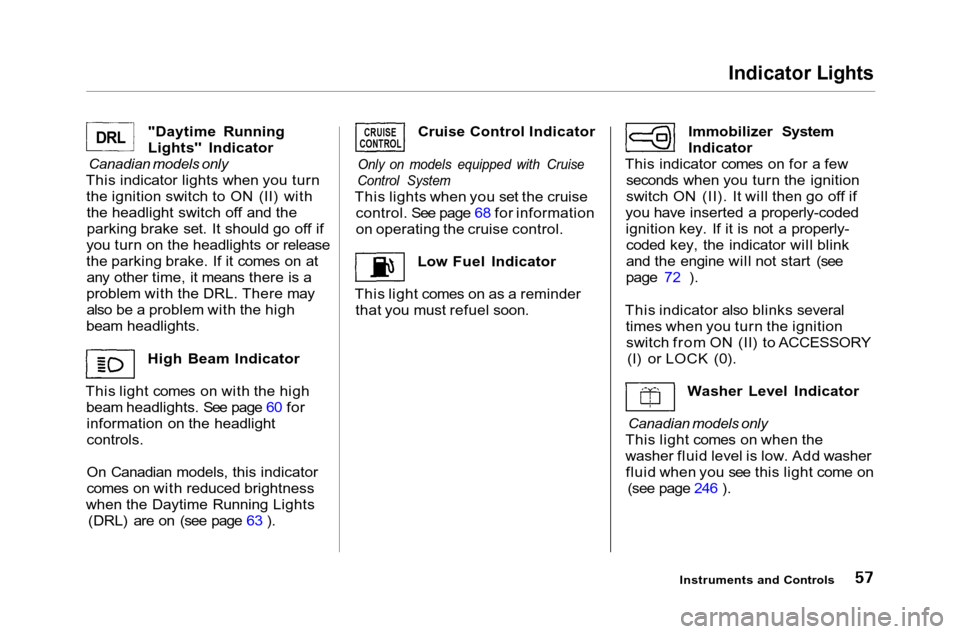
Indicator Lights
"Daytime Running
Lights" Indicator
Canadian models only
This indicator lights when you turn the ignition switch to ON (II) withthe headlight switch off and the
parking brake set. It should go off if
you turn on the headlights or release
the parking brake. If it comes on at any other time, it means there is a
problem with the DRL. There may also be a problem with the high
beam headlights.
High Beam Indicator
This light comes on with the high beam headlights. See page 60 forinformation on the headlight
controls.
On Canadian models, this indicator
comes on with reduced brightness
when the Daytime Running Lights (DRL) are on (see page 63 ). Cruise Control Indicator
Only on models equipped with Cruise
Control System
This lights when you set the cruise control. See page 68 for information
on operating the cruise control.
Low Fuel Indicator
This light comes on as a reminder that you must refuel soon. Immobilizer System
Indicator
This indicator comes on for a few seconds when you turn the ignition
switch ON (II). It will then go off if
you have inserted a properly-coded ignition key. If it is not a properly-coded key, the indicator will blink
and the engine will not start (see
page 72 ).
This indicator also blinks several times when you turn the ignitionswitch from ON (II) to ACCESSORY (I) or LOCK (0).
Washer Level Indicator
Canadian models only
This light comes on when the
washer fluid level is low. Add washer fluid when you see this light come on (see page 246 ).
Instruments and Controls
CRUISE
CONTROL
DRL
Page 222 of 372
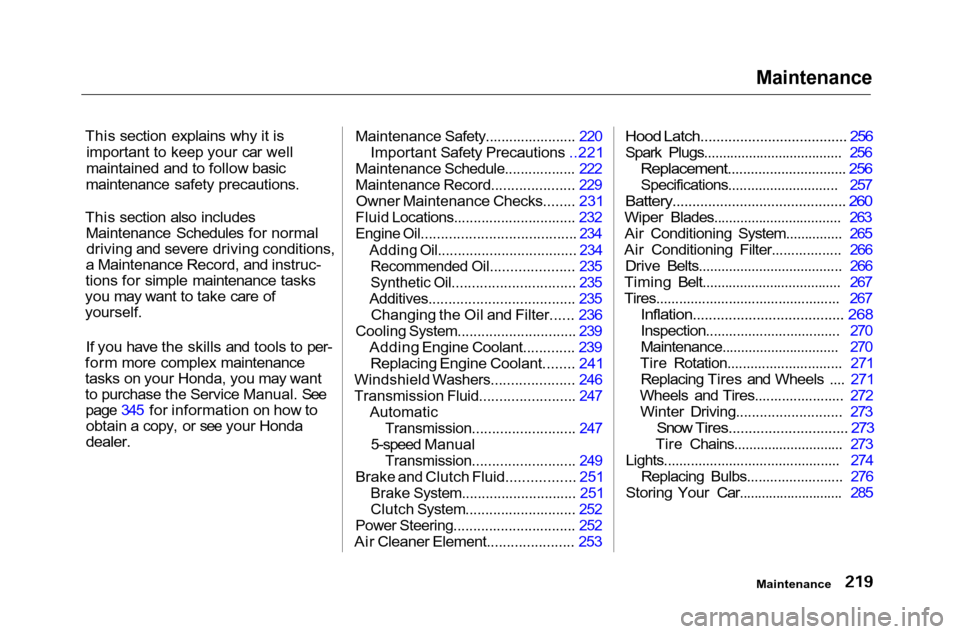
Maintenance
This section explains why it is important to keep your car well
maintained and to follow basic
maintenance safety precautions.
This section also includes Maintenance Schedules for normaldriving and severe driving conditions,
a Maintenance Record, and instruc-
tions for simple maintenance tasks
you may want to take care of
yourself.
If you have the skills and tools to per-
form more complex maintenance
tasks on your Honda, you may want
to purchase the Service Manual. See page 345 for information on how toobtain a copy, or see your Honda
dealer.
Maintenance Safety....................... 220
Important Safety Precautions ..221
Maintenance Schedule.................. 222
Maintenance Record..................... 229
Owner Maintenance Checks........ 231
Fluid Locations............................... 232
Engine Oil....................................... 234
Adding Oil................................... 234Recommended Oil..................... 235
Synthetic Oil............................... 235
Additives..................................... 235
Changing the Oil and Filter...... 236
Cooling System.............................. 239
Adding Engine Coolant............. 239Replacing Engine Coolant........ 241
Windshield Washers..................... 246
Transmission Fluid........................ 247
Automatic
Transmission.......................... 247
5-speed Manual
Transmission.......................... 249
Brake and Clutch Fluid................. 251
Brake System............................. 251
Clutch System............................ 252
Power Steering............................... 252
Air Cleaner Element...................... 253
Hood Latch..................................... 256
Spark Plugs..................................... 256
Replacement............................... 256
Specifications............................. 257
Battery............................................ 260
Wiper Blades.................................. 263
Air Conditioning System............... 265
Air Conditioning Filter.................. 266 Drive Belts...................................... 266
Timing Belt..................................... 267
Tires................................................ 267
Inflation...................................... 268
Inspection................................... 270
Maintenance............................... 270
Tire Rotation.............................. 271 Replacing Tires and Wheels .... 271
Wheels and Tires....................... 272 Winter Driving........................... 273
Snow Tires.............................. 273
Tire Chains............................. 273
Lights.............................................. 274 Replacing Bulbs......................... 276
Storing Your Car............................ 285
Maintenance
Page 234 of 372

Owner Maintenance Checks
You should check the following items at the specified intervals. If
you are unsure of how to perform any check, turn to the page given. Engine oil level — Check every
time you fill the fuel tank. See
page 182. Engine coolant level — Check the
radiator reserve tank every time
you fill the fuel tank. See page 184 .
Windshield washer fluid — Check
the level in the reservoir monthly.If weather conditions cause you to
use the washers frequently, check
the reservoir each time you stop
for fuel. See page 246 . Automatic transmission — Check
the fluid level monthly. See page 247. Brakes — Check the fluid level
monthly. See page 251.
Tires — Check the tire pressure
monthly. Examine the tread for
wear and foreign objects. See page
267.
Lights — Check the operation of
the headlights, parking lights,
taillights, high-mount brake light,
turn signals, brake lights, and
license plate lights monthly. See
page 274.
Maintenance
Page 235 of 372
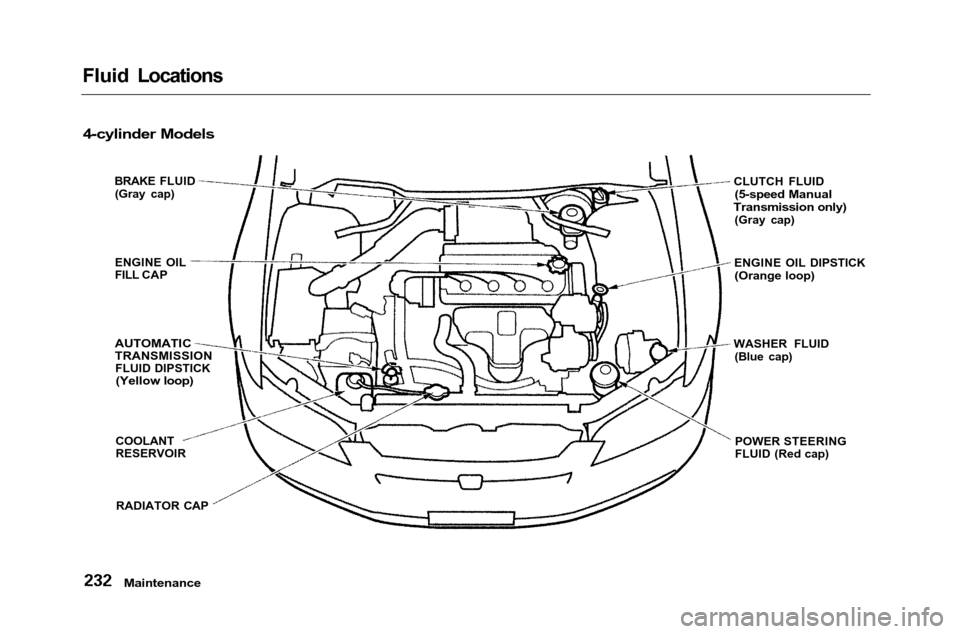
Fluid Locations
Maintenance
4-cylinder Models
BRAKE FLUID(Gray cap)
ENGINE OIL
FILL CAP
AUTOMATIC
TRANSMISSION
FLUID DIPSTICK
(Yellow loop)
COOLANT
RESERVOIR
CLUTCH FLUID
(5-speed Manual
Transmission only)
(Gray cap)
ENGINE OIL DIPSTICK
(Orange loop)
WASHER FLUID (Blue cap)
POWER STEERING
FLUID (Red cap)
RADIATOR CAP
Page 236 of 372

Fluid Locations
Maintenance
RADIATOR CAP
COOLANT
RESERVOIR
AUTOMATIC
TRANSMISSION
FLUID DIPSTICK
(Yellow loop)
6-cylinder Models
ENGINE OILFILL CAP
ENGINE OIL DIPSTICK
(Orange loop)
WASHER FLUID (Blue cap) BRAKE FLUID
(Gray cap)
POWER STEERING
FLUID (Red cap)
Page 254 of 372
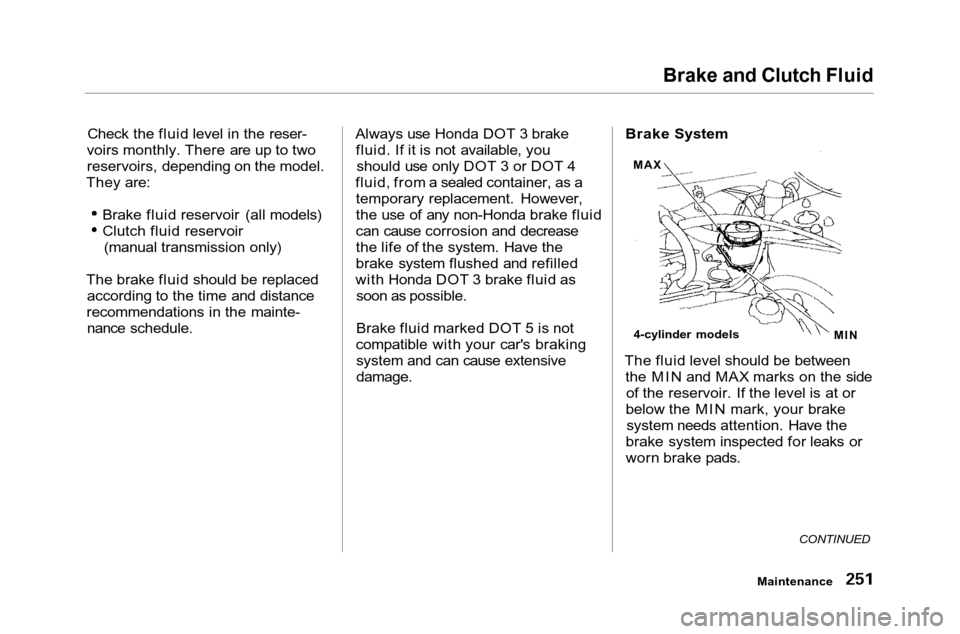
Brake and Clutch Fluid
Check the fluid level in the reser-
voirs monthly. There are up to two reservoirs, depending on the model.
They are:
Brake fluid reservoir (all models)
Clutch fluid reservoir(manual transmission only)
The brake fluid should be replaced according to the time and distance
recommendations in the mainte- nance schedule. Always use Honda DOT 3 brake
fluid. If it is not available, you should use only DOT 3 or DOT 4
fluid, from a sealed container, as a temporary replacement. However,
the use of any non-Honda brake fluid
can cause corrosion and decrease
the life of the system. Have the
brake system flushed and refilled
with Honda DOT 3 brake fluid as soon as possible.
Brake fluid marked DOT 5 is not
compatible with your car's braking system and can cause extensive
damage.
Brake System
4-cylinder models
MIN
The fluid level should be between the MIN and MAX marks on the sideof the reservoir. If the level is at or
below the MIN mark, your brake system needs attention. Have the
brake system inspected for leaks or
worn brake pads.
CONTINUED
Maintenance
MAX
Page 255 of 372
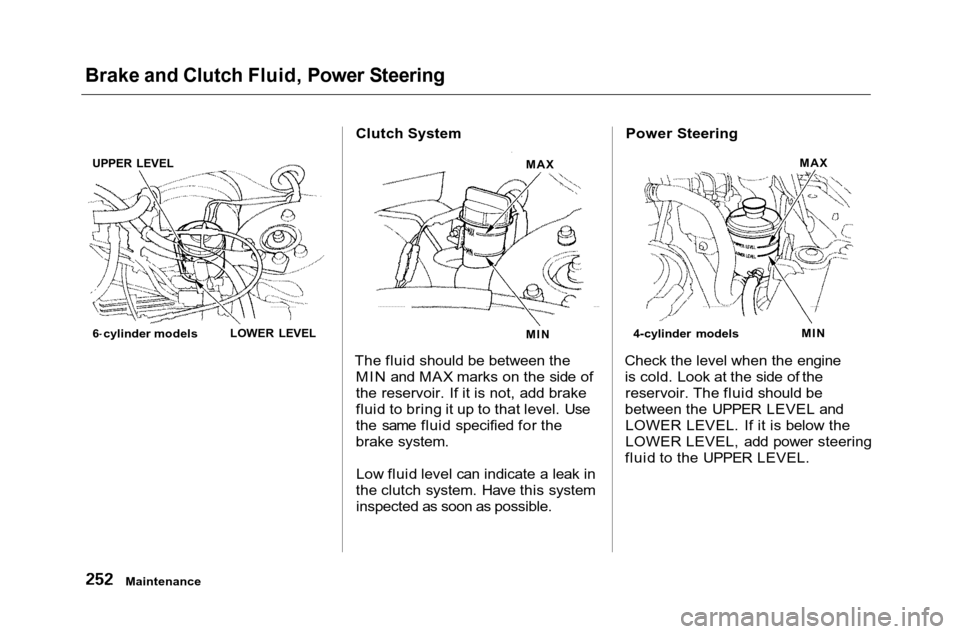
Brake and Clutch Fluid, Power Steering
Clutch System
The fluid should be between the MIN and MAX marks on the side of
the reservoir. If it is not, add brake
fluid to bring it up to that level. Use
the same fluid specified for the
brake system.
Low fluid level can indicate a leak in
the clutch system. Have this system inspected as soon as possible. Power Steering
Check the level when the engine is cold. Look at the side of thereservoir. The fluid should be
between the UPPER LEVEL and LOWER LEVEL. If it is below the
LOWER LEVEL, add power steering
fluid to the UPPER LEVEL.
Maintenance
UPPER LEVEL
6 cylinder models
LOWER LEVEL
MIN MAX
4-cylinder models
MIN
MAX
Page 316 of 372
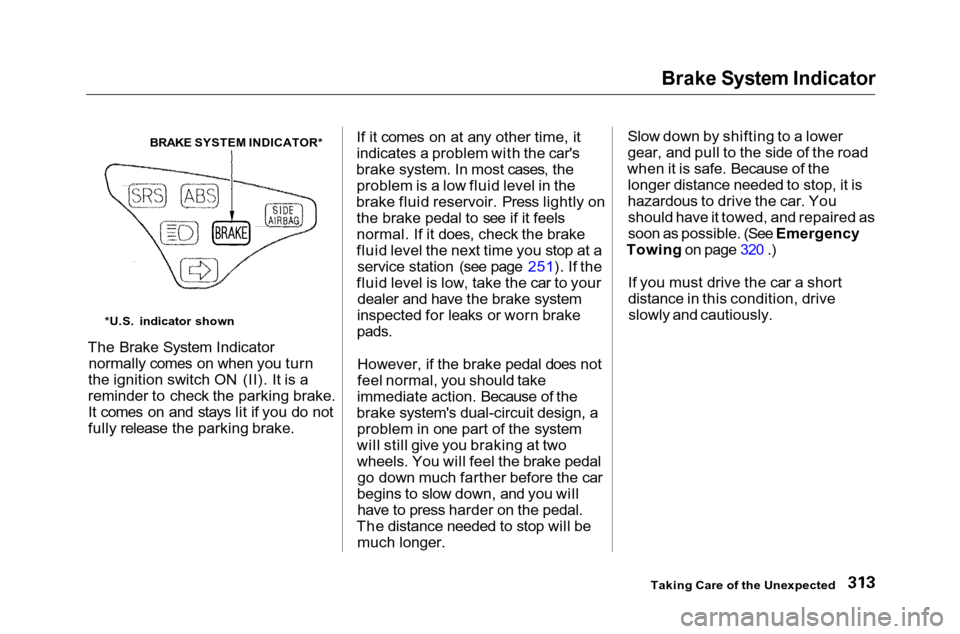
Brake System Indicator
BRAKE SYSTEM INDICATOR*
The Brake System Indicator normally comes on when you turn
the ignition switch ON (II). It is a
reminder to check the parking brake.
It comes on and stays lit if you do not
fully release the parking brake. If it comes on at any other time, it
indicates a problem with the car's
brake system. In most cases, the problem is a low fluid level in the
brake fluid reservoir. Press lightly on the brake pedal to see if it feels
normal. If it does, check the brake
fluid level the next time you stop at a service station (see page 251). If the
fluid level is low, take the car to your dealer and have the brake system
inspected for leaks or worn brake
pads.
However, if the brake pedal does not
feel normal, you should take
immediate action. Because of the
brake system's dual-circuit design, a problem in one part of the system
will still give you braking at two
wheels. You will feel the brake pedalgo down much farther before the car
begins to slow down, and you will have to press harder on the pedal.
The distance needed to stop will be much longer. Slow down by shifting to a lower
gear, and pull to the side of the road
when it is safe. Because of the longer distance needed to stop, it is
hazardous to drive the car. Youshould have it towed, and repaired as
soon as possible. (See Emergency
Towing on page 320 .)
If you must drive the car a short
distance in this condition, driveslowly and cautiously.
Taking Care of the Unexpected
*U.S. indicator shown
Page 350 of 372

Index
Accessories and Modifications.... 186 Accessories................................. 186Additional Safety Precaution.... 187 Modifications............................. 187
ACCESSORY (Ignition Key Position)........................................ 74
Accessory Power Socket.............. 106
Additives, Engine Oil..................... 234
Airbag (SRS) ...................................... 9
Air Cleaner Element...................... 253
Air Conditioning............................. 110
Maintenance............................... 265
Usage.......................................... 110
Air Conditioning Filter.................. 266
Air Pressure, Tires........................ 268
Alcohol in Gasoline........................ 331
Antifreeze....................................... 239
Anti-lock Brakes (ABS)
Description................................. 204
Indicator............................... 55, 205
Operation.................................... 204
Anti-theft Steering Column Lock.. 73
Appearance Care........................... 287
Audio System................ 125, 137, 153
Automatic Speed Control................
68
Automatic Transmission............... 196
Capacity, Fluid........................... 326
Checking Fluid Level....... 247, 249
Shifting........................................ 196
Shift Lever Position Indicator.. 197
Shift Lever Positions................. 197
Shift Lock Release..................... 200
Battery Charging System Light...... 54, 310
Jump Starting............................. 304
Maintenance............................... 260
Specifications............................. 329
Before Driving............................... 177
Belts, Seat........................................... 8
Beverage Holder............................ 104
Body Repair.................................... 296
Brakes Anti-lock System (ABS)............ 204Break-in, New Linings .............. 178
Bulb Replacement..................... 281
Fluid............................................ 251
Parking........................................ 101
System Indicator.......................... 55
Wear Indicators......................... 203
Braking System.............................. 203
Break-in, New Car......................... 178 Brightness Control, Instruments... 63
Brights, Headlights......................... 62
Bulb Replacement Back-up Lights........................... 281
Brake Lights............................... 281Ceiling Light............................... 282
Courtesy Light........................... 283
Front Parking Lights................. 278
Front Side Marker Lights......... 277
Headlights.................................. 276
High-mount Brake Light.......... 281
License Plate Lights.................. 281
Specifications............................. 327
Spotlight...................................... 283
Trunk Light................................ 284
Turn Signal Lights..................... 277
Bulbs, Halogen............................... 276
CONTINUED
Page 351 of 372
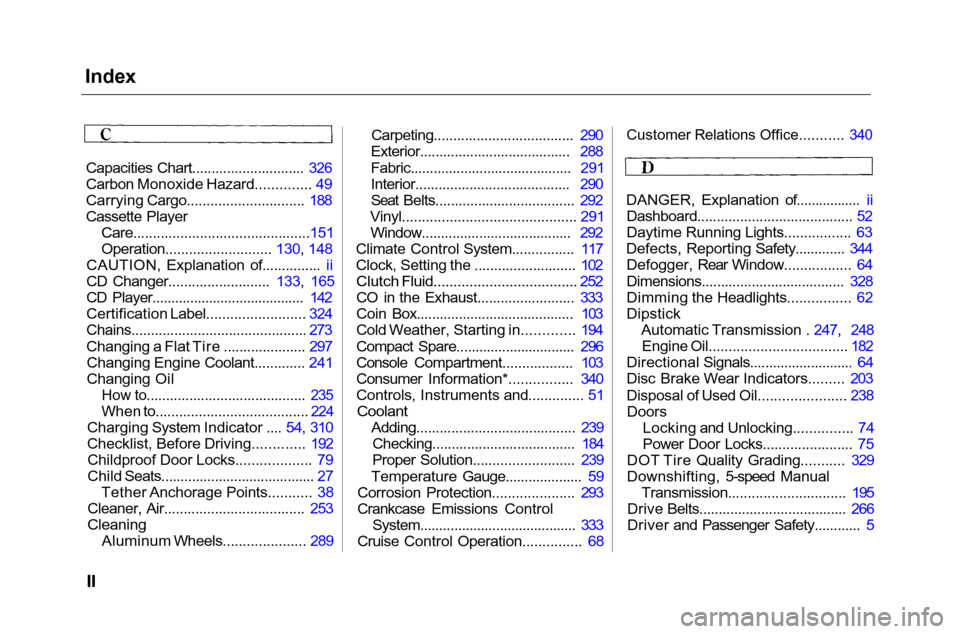
Index
Capacities Chart............................. 326
Carbon Monoxide Hazard.............. 49
Carrying Cargo.............................. 188
Cassette Player
Care.............................................151
Operation........................... 130, 148
CAUTION, Explanation of............... ii
CD Changer.......................... 133, 165
CD Player........................................ 142
Certification Label......................... 324
Chains............................................. 273
Changing a Flat Tire ..................... 297 Changing Engine Coolant.............
241
Changing Oil
How to......................................... 235
When to....................................... 224
Charging System Indicator .... 54, 310
Checklist, Before Driving............. 192 Childproof Door Locks................... 79
Child Seats........................................ 27 Tether Anchorage Points........... 38
Cleaner, Air.................................... 253
Cleaning
Aluminum Wheels..................... 289 Carpeting.................................... 290
Exterior....................................... 288
Fabric.......................................... 291
Interior........................................ 290
Seat Belts.................................... 292
Vinyl............................................ 291 Window....................................... 292
Climate Control System................ 117
Clock, Setting the .......................... 102
Clutch Fluid.................................... 252
CO in the Exhaust......................... 333
Coin Box......................................... 103
Cold Weather, Starting in............. 194
Compact Spare............................... 296
Console Compartment.................. 103
Consumer Information*................ 340
Controls, Instruments and..............
51
Coolant
Adding......................................... 239Checking..................................... 184
Proper Solution.......................... 239
Temperature Gauge.................... 59
Corrosion Protection..................... 293
Crankcase Emissions Control System......................................... 333
Cruise Control Operation............... 68
Customer Relations Office........... 340
DANGER, Explanation of................. ii Dashboard........................................ 52
Daytime Running Lights................. 63
Defects, Reporting Safety............. 344 Defogger, Rear Window................. 64
Dimensions..................................... 328
Dimming the Headlights................ 62
Dipstick Automatic Transmission . 247, 248
Engine Oil................................... 182
Directional Signals........................... 64
Disc Brake Wear Indicators......... 203
Disposal of Used Oil...................... 238 Doors Locking and Unlocking............... 74
Power Door Locks....................... 75
DOT Tire Quality Grading........... 329
Downshifting, 5-speed Manual Transmission.............................. 195
Drive Belts...................................... 266
Driver and Passenger Safety............ 5